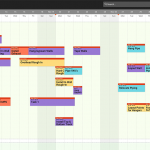Welcome to the second installment of Touchplan’s ConTech series. In this piece, we take stock of current construction technology offerings, discuss how market forces shape the ConTech landscape, and explain how to evaluate return on investment.
Construction technology is a broad category, encompassing everything from artificial intelligence to translucent concrete. While the industry as a whole hasn’t seen as much innovation as others, there are certainly changes underway. To navigate this evolving landscape and take maximum advantage, it’s important to understand the different types of construction technology available, and to determine what might be useful for your business and your objectives. There are five areas that most construction technologies fall into: team collaboration software, wearables and mobile sensors, automation, material improvements, and prefab or offsite construction.
Top Innovation Areas in Construction
1. Team Collaboration Software
As construction projects continue to increase in complexity, there is rising demand for systems to facilitate collaboration. This is arguably the hottest area right now. Document control systems, drawing review software, and virtual planning tools all aim to keep project teams aligned with critical project data made accessible by anyone, from anywhere—putting it right at their fingertips.
Dashboards are another important innovation in this space. Dashboards are a highly effective way to display data that’s being collected in real time to keep tabs on the current state of a project and help anticipate what the future state will be. Having this information readily available helps project teams work together more efficiently.
2. Wearables and Mobile Sensors
While perhaps not yet at the forefront of the construction industry, wearables will become more prevalent as they become more commonplace in other industry segments. Wearables can be used to monitor and capture data automatically, and can provide real-time, contextually relevant information back to the wearer. You’re probably familiar with wearables like GPS trackers, heart rate monitors and step counters. Camera-equipped drones aren’t technically wearables, but they are nonetheless mounted on a mobile platform and serve a similar function. Expect to see more and more devices of this genre used in construction in the years to come.
3. Automation
Automation is another important area of construction technology. Much of the building process consists of manual, repetitive tasks, some of which can be automated using robotics and other modern tools and equipment. Humans are still integral to the process, but it’s an obvious advantage if particularly dangerous or taxing work can be done by machines. According to the American Society of Mechanical Engineers, some of the latest tools and techniques being developed in this category include robotic mesh makers and bricklayers, 3D printing and drone construction.
4. Material Improvements
There has been significant innovation in the types of building materials available. According to Architect Magazine, solar facades that regulate the interior temperature of a structure, self-healing concrete, and plastic made from shrimp shells to be as strong as aluminum are just some of the futuristic building materials coming onto the market today.
5. Prefab Construction
Prefab (or offsite) construction, in which a structure is partially assembled elsewhere and then transported to a jobsite, is another form of process automation that is gaining in popularity. According to Construction World, prefab construction offers numerous benefits, including financial savings; reduced waste; shorter construction time; increased safety, quality and flexibility; and reduced site disruption.
How the Market Influences Your Options
With all of the technology coming into the industry, it can be daunting to try to determine which products or solutions are the game-changers they claim to be. The path to every successful technology is littered with also-rans, the names of which are quickly forgotten. How do the top products in each category emerge?
The reality of the selection process isn’t as straightforward as it often appears. The market plays a considerable role in selecting which products achieve commercial success, and not always for the reasons one might think. This is due in large part to what Geoffrey A. Moore calls the “technology adoption life cycle.” According to Moore’s book, Crossing the Chasm, most technological innovations follow a similar process in becoming broadly adopted (or not). There are five core groups that Moore identifies when it comes to technology adoption, and each group has different outlooks, priorities and behaviors. The first group, dubbed “innovators,” are tech-savvy and actively on the hunt for new technology, sometimes before it’s even brought to market. They are curious to explore new technology and aren’t intimidated by the unfamiliar.
After a technology has been embraced by innovators, the next group to adopt it are the “early adopters.” Early adopters are similar to innovators in their enthusiasm for new technology, but tend to base their buying decisions on an intuition that a given product will offer them an advantage.
After innovators and early adopters have been exposed to a new technology, there is a often a gap in uptake (the “chasm” that Moore refers to). The gap is the time it takes for a product to be embraced by the early majority. The early majority consists of people who are open to technology but driven by practicality, and typically they want to see proof that a product is being adopted by their peers and won’t turn out to be a flash in the pan. No matter how good a product is, it’s not likely to be successful if it doesn’t manage to win over the early majority. The product(s) embraced by the early majority tend to be the ones that manage to stay on the market, so in this way, the early majority makes the selection as to what technology remains available and what disappears into oblivion.
The next group is the late majority, which is like the early majority in its need to see widespread acceptance of a product before buying in. The late majority is typically less comfortable with technology than the previous three groups, and tends to only feel comfortable purchasing new technology if it comes with established standards and widely available support.
The final group is—rather unflatteringly—referred to as “laggards.” Laggards avoid buying technology and only do so when it’s essentially concealed from them within a different product. You probably don’t know anyone like this.
Focus on ROI
While it may be strange to know that your buying choices aren’t entirely your own, it’s also reassuring to remember that you’re never the only one making these decisions. If you’re considering a new technology, chances are many others in your field are as well, and you can take cues from them if you’re unsure. Or, you can decide to position your company as an early adopter.
The primary considerations when investing in any of these solutions should be the long-term advantage they offer your business. Ideally, the technology you purchase will pay for itself in a short amount of time and save you money in the long run. Will automating a particular process alleviate a labor shortage you’ve experienced, or produce more consistent results? Is there an especially dangerous task that a machine could do instead of an employee? And on the materials side, is there a new type of building material that would give you a competitive advantage and win you more work?
If you’re buying software, it’s important to look for solutions that currently integrate or plan to offer integrations with other products. Cloud-based software offers ease of access and facilitates data sharing and integration. Ease of use is another key consideration, so look for software with an approachable interface and good user experience.
Above all, don’t be intimidated by technology. While researching options and making purchasing decisions can seem overwhelming, the long-term benefits definitely outweigh the hassle. A strategic technology investment can help your business not only weather labor shortages and rising material costs, but expand and win more work.
To learn how Touchplan can help your business, click here to view a demo.










